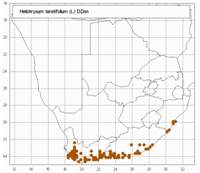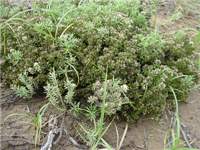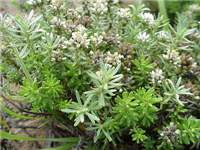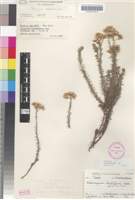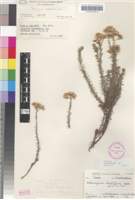Origin of name:
teretifolium = tereti= smooth, rounded off elegantfolium = leaves
Diagnostic characters:
Needle-like leaves, very fine and closely spacedLarge headsOff-white / cream coloured bracts, occasionally tinged pinkOpen branched inflorescence
Description:
Much-branched compact or straggling subshrub up to c. 300 mm tall, branchlets thinly white-felted, closely leafy to summit. Leaves c. 3-15 x 1-1.5 mm, not diminishing upwards, linear, rigid, spreading, margins revolute, tip uncinate, base shortly decurrent, upper surface soon glabrous, lower white-woolly. Heads heterogamous or very rarely homogamous, campanulate, c. 5 x 5 mm, few to several in compact terminal corymbs. Involucral bracts in 6-8 series, graded, imbricate, inner slightly exceeding flowers, tips very obtuse, crisped, opaque creamy-white or outer sometimes rosy, minutely radiating. Receptacle with fimbrils exceeding ovaries. Flowers 17-60, (0-) 2-14 female, 10-49 homogamous. Achenes c. 1 mm long, glabrous or with myxogenic duplex hairs. Pappus bristles many, about equaling corolla, tips barbellate, bases cohering by patent cilia.
Flowers between July and November.
Distribution:
Grows in shrub communities, often on sand, on stabilized dunes near the sea or on mountain slopes, often in dense stands. Ranges from Piquetberg and the Great Winterhoek Mountains through the SW. and southern Cape to the Eastern Cape as far inland as Grahamstown and Dohne, thence along the coast to KwaZulu-Natal, where it reaches the northern limit of its distribution at Durban Bluff.
Fynbos, Thicket and Savanna Biomes.
Taxonomy:
Literature:
Helichrysum teretifolium (L.) D. Don in Sweet, Hort. Brit. 223 (1826); Less., Syn. Comp. 312 (1832); DC., Prodr. 6: 205 (1838); Harv. in F.C. 3: 250 (1865); Wood & Evans, Natal Plants 4: 327 (1906); Moeser in Bot. Jb. 44: 283 (1910); Levyns in Adamson & Salter, Fl. Cape Penins. 784 (1950); Batten & Bokelmann, Wild Flow. E. Cape Prov. 160, plate 127,7 (1966); Hilliard, Compositae in Natal 197 (1977).
Type:
Gnaphalium no. 2 in herbarium Cliff. (BM).
Synonym(s):
Gnaphalium teretifolium L., Sp. Pl. 854 (1753).
G. scoparium Schrank in Denkschr. K. Akad. Wiss. M�nch. 8: 160 (1824). Type: Cape of Good Hope, Brehm s.n. (M, holo.; S, iso.).
Helichrysum teretifolium var. congestum DC., Prodr. 6: 205 (1838). Lectotype: Cape, mouth of Great Fish River, W. side, Burchell 3731 (G-DC misquoted by DC., 1. c. as 373). H. teretifolium var. rufescens DC., 1. c. Type: Cape, Mossel Bay, seashore, Burchell 6252 (G-DC). H. teretifolium var. umbelliforme DC., 1. c. Lectotype: Cape, Riversdale div., Soetemelks (sphalm. Troetemelks) River, Burchell 6660 (G-DC). H. teretifolium var. natalense Harv. in F.C. 3: 250 (1865). Lectotype: KwaZulu-Natal, in dunis prope litus, Natal point, July 1839, Krauss 291 (TCD; G; M, isolecto.).
Vouchers:
Acocks 9141 (PRE); Compton 7594 (NBG); Esterhuysen 10681 (BOL; NBG; PRE); Hilliard 3995 (E; K; NH; NU); MacOwan 215 (SAM).